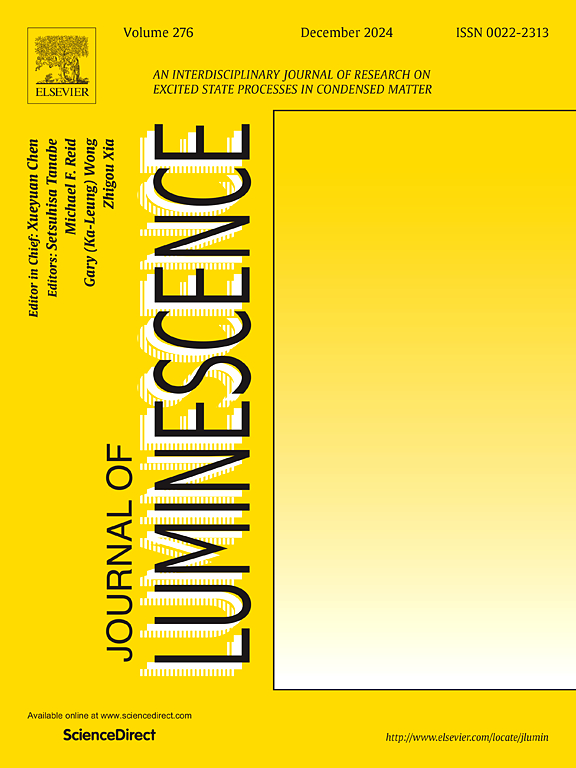掺镝SrY2O4单晶的光致发光和闪烁特性
IF 3.3
3区 物理与天体物理
Q2 OPTICS
引用次数: 0
摘要
目前,CdWO4、Tl:CsI和Pr:Gd2O2S是x射线探测器常用的闪烁体;然而,就含有有害的镉、潮解和光学透明度而言,每一种都有固有的缺点。为了开发解决这些问题的新型闪烁体,采用浮区法合成了Sr(Y1-xDyx)2O4 (x = 0.05%, 0.1%, 0.5%和1%)单晶,并对其光致发光和闪烁性能进行了评价。在x射线照射下观察到Dy3+的4f-4f跃迁对应的发射峰。其中,x = 0.1%的样品在γ射线照射下的闪烁产光率最高,为15,000光子/MeV,与市售的CdWO4(15,800光子/MeV)相当。虽然余辉水平需要进一步提高,但目前的研究结果表明,这种闪烁体具有良好的光产率和高的化学稳定性,没有有毒元素。本文章由计算机程序翻译,如有差异,请以英文原文为准。
Photoluminescence and scintillation properties of Dy-doped SrY2O4 single crystals
Currently, CdWO4, Tl:CsI, and Pr:Gd2O2S are commonly used scintillators for X-ray detectors; however, each has inherent drawbacks in terms of containing harmful Cd, deliquescence, and optical transparency. With the aim of developing new scintillators that solve these issues, Sr(Y1-xDyx)2O4 (x = 0.05 %, 0.1 %, 0.5 %, and 1 %) single crystals were synthesized using the floating zone method, and their photoluminescence and scintillation properties were evaluated. Emission peaks corresponding to the 4f–4f transitions of Dy3+ were observed under X-ray irradiation. Among the samples, the x = 0.1 % sample exhibited the highest scintillation light yield of 15,000 photons/MeV under γ-ray irradiation, comparable to commercially available CdWO4 (15,800 photons/MeV). Although the afterglow level requires further improvement, the present results suggest a promising scintillator showing good light yield and high chemical stability without toxic elements.
求助全文
通过发布文献求助,成功后即可免费获取论文全文。
去求助
来源期刊

Journal of Luminescence
物理-光学
CiteScore
6.70
自引率
13.90%
发文量
850
审稿时长
3.8 months
期刊介绍:
The purpose of the Journal of Luminescence is to provide a means of communication between scientists in different disciplines who share a common interest in the electronic excited states of molecular, ionic and covalent systems, whether crystalline, amorphous, or liquid.
We invite original papers and reviews on such subjects as: exciton and polariton dynamics, dynamics of localized excited states, energy and charge transport in ordered and disordered systems, radiative and non-radiative recombination, relaxation processes, vibronic interactions in electronic excited states, photochemistry in condensed systems, excited state resonance, double resonance, spin dynamics, selective excitation spectroscopy, hole burning, coherent processes in excited states, (e.g. coherent optical transients, photon echoes, transient gratings), multiphoton processes, optical bistability, photochromism, and new techniques for the study of excited states. This list is not intended to be exhaustive. Papers in the traditional areas of optical spectroscopy (absorption, MCD, luminescence, Raman scattering) are welcome. Papers on applications (phosphors, scintillators, electro- and cathodo-luminescence, radiography, bioimaging, solar energy, energy conversion, etc.) are also welcome if they present results of scientific, rather than only technological interest. However, papers containing purely theoretical results, not related to phenomena in the excited states, as well as papers using luminescence spectroscopy to perform routine analytical chemistry or biochemistry procedures, are outside the scope of the journal. Some exceptions will be possible at the discretion of the editors.
 求助内容:
求助内容: 应助结果提醒方式:
应助结果提醒方式:


